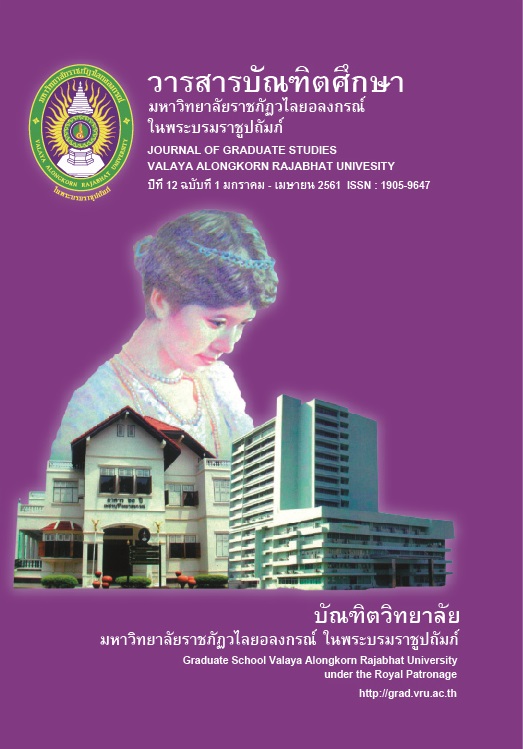กลวิธีการสร้างคุณานุประโยคของผู้เรียนชาวจีนที่เรียนภาษาไทย
Main Article Content
Abstract
การศึกษาการสร้างคุณานุประโยคภาษาไทยของกลุ่มตัวอย่างชาวจีนที่เรียนภาษาไทยเป็นภาษาที่สองนี้เพื่อศึกษากลวิธีที่กลุ่มตัวอย่างใช้ในการสร้างคุณานุประโยค 3 ประเภท 6 โครงสร้าง โดยคุณานุประโยคทั้ง 3 ประเภทคือ คุณานุประโยคประเภทประธาน คุณานุประโยคประเภทกรรมตรงและคุณานุประโยคประเภทกรรมรอง ขยายคำนามหลักตำแหน่งประธานและตำแหน่งกรรมตรง (SS/OS/SO/ OO/SIO/OIO) โดยสัญลักษณ์ตัวแรกคือตำแหน่งนามหลัก ส่วนสัญลักษณ์ตัวที่สอง คือประเภทคุณานุประโยค โดยศึกษากับผู้เรียนชาวจีนที่เรียนภาษาไทยมา 2 ปี จำนวน 20 คน ด้วยแบบทดสอบ 2 ประเภทคือ และแบบทดสอบการรวมประโยค (SCT) และแบบทดสอบการเขียนบรรยายรูปภาพ (PDWT) ผลการศึกษาพบว่ากลุ่มตัวอย่างชาวจีนสร้างคุณานุประโยคภาษาไทยด้วยการใช้กลวิธีช่องว่าง (gap strategy) โดยใช้ร่วมกับตัวบ่งชี้ “ที่” มากที่สุด นอกจากนั้นยังพบการใช้กลวิธีสรรพนามและนามวลีด้วยกลุ่มตัวอย่างสร้างคุณานุประโยคประเภทประธานขยายคำนามหลักตำแหน่งกรรมตรงได้ถูกต้องมากที่สุด (OS) และกลุ่มตัวอย่างสร้างคุณานุประโยคประเภทประธานขยายคำนามหลักตำแหน่งประธาน (SS) ได้ถูกต้องน้อยที่สุด เนื่องจากกลุ่มตัวอย่างสร้างคุณานุประโยคจากประโยคที่กำหนดให้สร้างเป็นประโยคหลัก นอกจากนั้นกลุ่มตัวอย่างสร้างยังใช้กลวิธีอื่น ๆ สร้างคุณานุประโยคที่ไม่เป็นที่ยอมรับจากเจ้าของภาษา เช่น การละตัวบ่งชี้ การใช้คำเชื่อม (discourse marker)
The current study aims to study the relativization of Thai relative clauses produced by Chinese Thai learners. Three types of relative clauses - subject, direct object, and indirect object which modify head noun in subject and object positions were examined with the sentence combination and picture description writing tests. The subjects have learned Thai for two years. The result showed that the strategies mostly used are gap strategies which were used with the marker. The followings were used were the pronoun and the noun phrase strategies. The subject relative clauses modifying objects (OS) were produced most correctly, and the ones produced least correctly are subject relative clause modifying subjects because they changed the main clauses into relative clauses. The other strategies, for example, the omission of the marker, the usage of discourse marker, etc., which were used were not accepted by the native speakers.
Article Details

This work is licensed under a Creative Commons Attribution-NonCommercial-NoDerivatives 4.0 International License.
บทความทุกเรื่องได้รับการตรวจความถูกต้องทางวิชาการโดยผู้ทรงคุณวุฒิ ทรรศนะและข้อคิดเห็นในบทความ Journal of Global of Perspectives in Humanities and Social Sciences (J-GPHSS) มิใช่เป็นทรรศนะและความคิดของผู้จัดทำจึงมิใช่ความรับผิดชอบของบัณฑิตวิทยาลัย มหาวิทยาลัยราชภัฏวไลยอลงกรณ์ ในพระบรมราชูปถัมภ์ กองบรรณาธิการไม่สงวนสิทธิ์การคัดลอก แต่ให้อ้างอิงแหล่งที่มา
References
สถานกงสุลใหญ่ ณ นครคุณหมิง. (2555 13 มิถุนายน). ความร่วมมือทางด้านการศึกษา. สืบค้นเมื่อ 12 ธันวาคม 2557. สืบค้นจาก https://www.thaiembassy.org/kunming/th/thai-people
อมรา ประสิทธิ์รัฐสินธ์, กิติมา อินทรัมพรรย์, และ นัฐวุฒิ โชยเจริญ. (2554). ไวยากรณ์ไทยฉบับครอบคลุมภาษาย่อย (A Pan-Dialectal Grammar of Thai). ฝ่ายวิชาการสำนักงาน กองทุนสนับสนุนการวิจัย. สำนักงานคณะกรรมการการอุดมศึกษา (ศกอ.) และสำนักงานกองทุนสนับสนุนการวิจัย (สกว.).
Amara, N. (2015). Errors Correction in Foreign Language Teaching. The Online Journal of New Horisons in Education. Volume 5, Issue 3.
Cook, V. (2003). Linguistics and Second Language Acquisition. Palgrave. New York: Basil Blackwell.
Ellis, R. (1994). The Study of Second Language Acquisition. Oxford. Oxford University Press.
Frith, B. (1977). Interlanguage Theory: Implications for the Classroom. Paper presented at the University of Toronto TESL on Second Language Learning Theory: A perspective for the classroom teacher. May, 1977.
Gass, S. & Selinker, L. (2008). Second language acquisition: An introductory course. 3rd ed. Routledge, Taylor & Francis Group.
Hasyim, S. (2002). Error Analysis in the Teaching of English. K@taJournal by English Department, Faculty of Letters, Petra Christian University, Surabaya, Indonesia. Volume 4. Edited by Aylanda Hidayati Dwi Nugroho and Esther Kuntjara.
Izumi, S. (2003). Processing Difficulty in Comprehension and Production of Relative Clauses by Learners of English as a Second Language. Language Learning 53:2 June 2003, pp. 285-323.
Keenan, E. & Comrie, B. (1977). Noun Phrase Accessibility and Universal Grammar. Linguistics Inquiry. Vol. 8, No. 1. pp 63 – 99.
Larsen, F. D. & Long H. M. (1991). An Introduction to Second Language Acquisition Research. Longman.
Lust, B. (2006). Child language Acquisition and Growth. Cambridge University Press.
Saville-Troike, M. (2006). Introducing Second Language Acquisition. Cambridge University Press.
Suh, J. (2011). EFL Korean Learners’ Use of Relative Clauses in Both Context-free and Context-rich Situations. English Teaching. 66(2), 189-210.
Xiaoling, J. & Mengduo, Q. (2010). Interlingual Factors in Chinese College Students’ Acquisition of English Relative Clauses. Chinese Journal of Applied Linguistics (Bimonthly). Vol.33, No.1.
You-Kyung, J. (2012). Typological Universals of relative clauses in relation to teaching Korean as a foreign language in Europe. SOAS, University of London.


